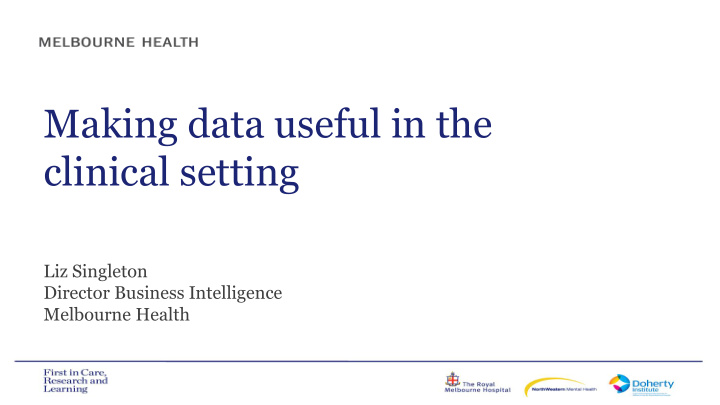



Making data useful in the clinical setting Liz Singleton Director Business Intelligence Melbourne Health
Melbourne Health • Employs 9,000+ staff across 33 sites • Over 76,000 Emergency presentations and over 101,000 admissions to RMH • Preparing for an Electronic Medical Record
Making data useful Our Business Intelligence journey • • Examples of clinical collaboration • Key lessons learnt
Melbourne Health Investment • Dedicated team & investment o Separate from IT o Warehouse expertise o Strong reporting capability o Clinical & business expertise • Establish one source of “truth” • High data security • Flexible & scalable solution
The first result… • Followed broad consultation • Designed to capture all feedback and ‘needs’ ‘ One-stop- shop’ approach to development Some people still prefer this one!
New approach Design Display Detail Clear need & Basic, visual & Facilitates audience focused interrogation specific & remains relevant
Collaborating for success
What to build for Nurse Unit Managers? • Focused topics chosen by the Chief Executive -12 initial key measures balanced scorecard -The top priority identified was Falls • The next step.. a conversation with NUMs -Two focus group sessions -We collected user stories about the data -We asked them what actions they take
A changed approach Basic. Visual. Focused Time of falls was an “Aha!” moment for some
Always improving Basic. Visual. Focused • Identify patients who fall more than once • Facilitate a validity check • Added median
Engaging Exec & clinical staff Ideas nominated by staff Exec Stewards Content meeting experts Over 40 Design & Wide use dashboards Refine in use
Collaborating for success practical examples 1.Using patient feedback 2.Working with wards 3.Working with medical staff
Responding to patient feedback Peer benchmark data indicated RMH was not providing sufficient discharge information 72% 72% 67% 64% 60% RMH VHES data Jul 2015- Jun 2016
Responding to Patient Feedback New application was built • Survey questions indicated areas of success and improvement • Results by ward and specialty tracked over time • Compliments and complaints received are displayed over time
Responding to patient feedback 50% improvement on pilot wards
Responding to patient feedback New updates • Daily data from automated process • Questions grouped into categories • Benchmark VHES data included • Funnel plot for recommender score by specialty and ward
Working with wards Before 10am Discharges Supporting improved processes
Working with wards “This multidisciplinary effort has led to the best result that our ward has ever recorded” (Nurse Unit Manager) “ Time to review our falls reduction strategies. Let’s focus to reverse this trend please. How many days since you have had a fall? Are they the focus of your rounds and huddles?” (Executive)
Increasing engagement of medical staff • Appointment of a doctor as informatics lead • New Head of Unit dashboard • Increased focus on research, maps, and predictive analytics
Lessons Learnt
• Just because you can display data doesn’t mean you should! • Two key questions before building a dashboard • Who is the audience? • What do you expect them to do with the information? • Display the detail and don’t wait for perfect data! • Refinement over time is beneficial • Linking data sources is powerful
Questions
Recommend
More recommend